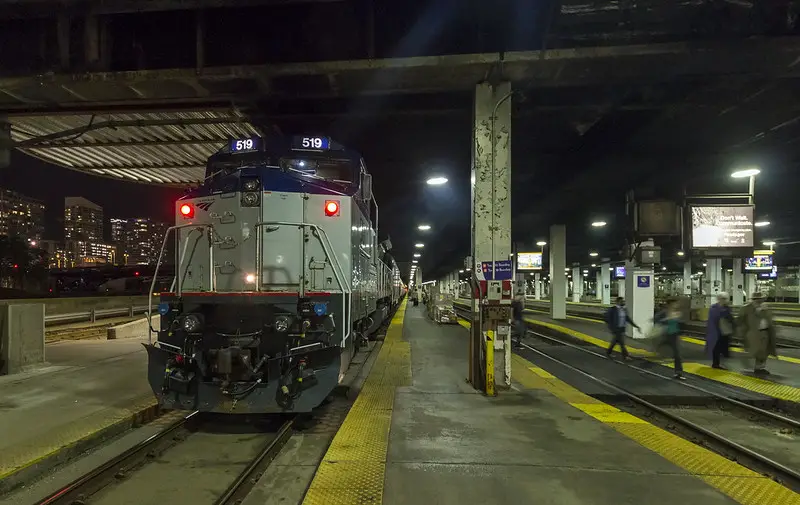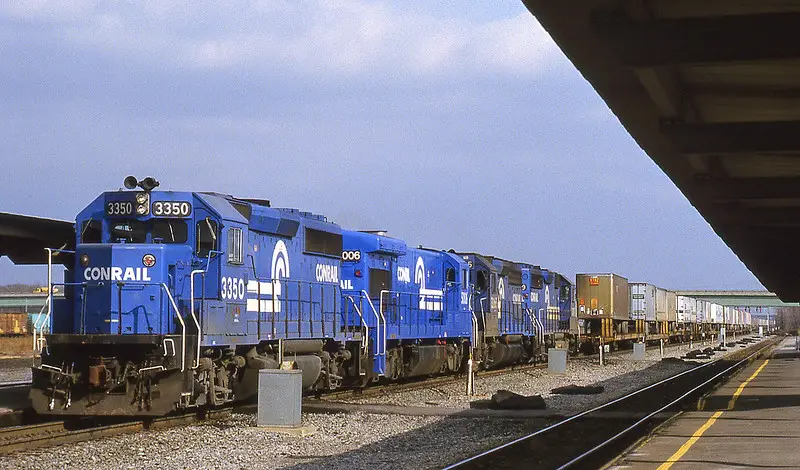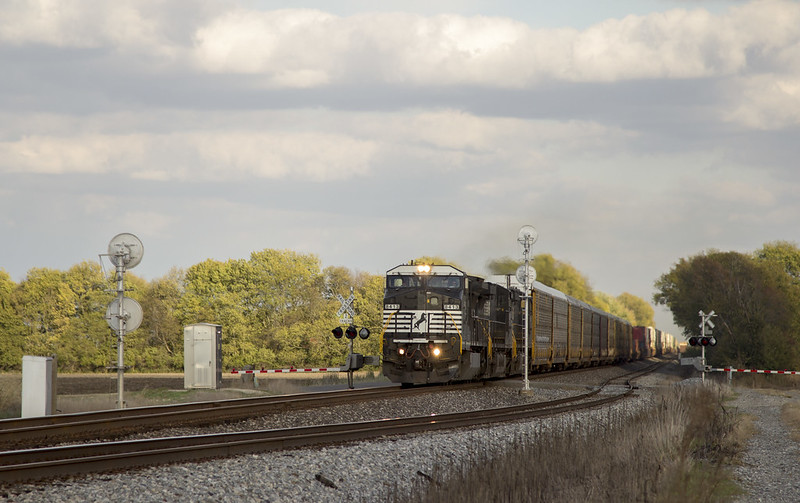Traveling by railroad is one of the coolest ways to see the country. You also have comfortable seats and other amenities that may be included to make the journey even better. Traveling by train at night seems like a fun idea, but does the railroad run 24/7?
Yes, however, the answer to this question depends on what train line you want to take. The Long Island Railroad does run 24/7. The MARTA does not run 24/7. Some railroads do not run 24/7 but have lines that do. You have to find the train line and route that meets your travel needs.
Railroads have remained a prominent mode of transportation since they were first introduced in 1827. So read on to find out more about the railroads and which ones run 24/7
Which Railroads Run 24/7?
These are the railroad lines that run 24 hours a day, 7 days a week.
Long Island Railroad
The Long Island Railroad or LIRR is the New York subway line that runs all day every day with each track having a different schedule. The line covers over 700 miles of track from Montauk to Penn Station. It is considered the busiest commuter railroad in North America, with 735 trains transporting 301,000 every day.
Port Authority Transit Corporation
The Port Authority Transit Corporation or PATCO has been in service since 1926 and serves stations from New Jersey to Pennsylvania. They are always updating and improving their lines so that passengers have the best experience possible. Trains run every 60 minutes and all stations have 24-hour 7 days a week service except 9/10th and Locust St. Station.
Chicago Transit Authority
The Chicago Transit Authority or CTA has a blue line that runs all day every day between O’Hare International Airport and the Forest Park Terminal through downtown Chicago. There are more than 20 stops across Chicago on this line. The CTA has been running since 1947 and is the second-largest public transportation system in North America.

Staten Island Railway
Part of New York City Transit and the only rapid train line on Staten Island. The train runs hourly and 24 hr service started during the pandemic and has continued since.
These are all the railroads that offer 24/7 service at the moment. These hours of operation are subject to change at any time at the discretion of railroad staff.
Are 24/7 railroads more expensive?
24/7 railroads are more expensive to take because it takes more resources to run them. You need to have a crew available to staff the train and the stations at all times, Railroads that run 24/7 also mean the train will require more maintenance because they are used more often.
Additionally, most of the 24/7 trains are high-speed trains, which are already more expensive than planes, More high-speed rail lines have not been implemented in the US because politicians are worried about the waste of infrastructure, the speed, the fact that high-speed trains cannot go everywhere, and that they will not be used more often than planes or cars.
Do cross-country trains run 24/7?
Cross country trains do not run 24/7. Traveling across the US by train is treated like a vacation, which must be booked and paid for. On cross-country train rides, your food and sleeping accommodations are included in the price of a trip. The reason why cross-country trains don’t run all the time is that it would be too difficult to get the staff and train ready for trips.
Amtrak is the best company for cross-country rail vacations. They have coast-to-coast trips as well as those focused on a specific region of the country.
Does the railroad work on holidays?
The railroad does work on holidays because people need to use it to travel to their destination. However, it may run on a special or reduced schedule. For example, the Florida Tri-Rail uses its weekend schedule on federal holidays like Christmas or Thanksgiving
What weather stops the railroad from running?
Adverse weather in the fall and winter can affect the railroads. The falling leaves in the fall and icy, snowy, and cold conditions in the winter can affect the train’s ability to take electricity, the functionality of signal points that exist for train safety, and the traction of the train’s wheels on the tracks. Here is how different adverse weather conditions affect trains.
Trips can either be canceled or delayed depending on the weather, it is up to each rail company to decide what is the safest path for the passengers and crew in each case.
Hot Weather
The hot weather can cause the rails to buckle and collapse or expand. So, when the weather becomes too hot, staff have to slow down trains to reduce pressure on the track. This makes the train take longer than normal to reach their destination which delays other trips.
When the rails come apart due to the high heat, trains have to use caution when traveling or stop service completely while they wait for repairs.

Rainy Weather
In areas that get a lot of rain, the flow of water can so heavy that it causes flooding. Severe or even minimal flooding can damage the train equipment, cause the train to lose power, or wash away the stone barrier around the track called ballast which weakens the track structure.
The more covered a train route is, the less it will be affected by rain. However, there is no way to predict the amount of cover or a route or add a new cover unless the rail company plans to send a crew out there to add it. Hurricanes, the most extreme rain condition, can cause trains to delay for hours.
Rainy weather can lead to rock or mudslides which block the train’s path and lead to delays or cancellations.
Fog
Rainy and humid conditions bring fog. Fog creates a haze that makes it harder for conductors to see signals, so they have to slow down the train to keep passengers safe. The slower speed of the train leads to delays in travel for passengers.
High Winds
Fast and strong winds often accompany heavy rain. If the wind is powerful enough, it can cause power lines to fall which will stop the train from working. High winds can also blow objects onto the track and prevent the train from continuing forward. This leads to travel delays and cancellations.
Incredibly strong winds can also cause train cars to fall over. So, the crew must use caution when operating in unusual wind conditions. Thunderstorm conditions and wind impair visibility and if lightning strikes, there is the possibility of a power outage on the train.
Leaves on The Line
As autumn transitions to winter, leaves fall from the trees leaving them bare. The fallen leaves could come onto the track and get caught in the wheels, preventing them from working properly. This leads to travel delays as train staff work to fix the issue.
Snow and Ice
Ice blocks the parts of the track that move, making it impossible for trains to move forward on their scheduled route and or causing conductors to have to find a different way to reach their destination. Ice can also frost over the power lines on the railway, making them malfunction.
Extreme cold can also cause the track to become brittle and break, making it impossible or unsafe for trains to cross
Ice can also coat the railroad itself, which keeps power from reaching the train. If the ice builds up too much, it can cause the doors to freeze shut, keeping the crew and passengers locked inside until help comes.
Snow removes the ballast that is on the track, weakens the structure of the bridges that the trains go over because of rust, and causes the roadbed to become soft due to the dampness.
If the train passes under a bridge lined with icicles and frost, the train may be damaged and need repairs. The ice can also cause rails that are already weak to break, preventing travel and causing delays. Too cold snow can cause the tracks to freeze together and the train can slip on them.
The tracks have to be plowed regularly in the winter to prevent these dangerous conditions. Empty ghost trains run on the tracks before passengers arrive to make sure everything runs smoothly before daily commutes, and parts of the track have heated components to prevent snow and ice buildup.
Snowstorms can also cause traffic jams on the track and prevent necessary supplies from being delivered. There are also scheduling problems due to all of the train lines trying to avoid the storm
To see if weather conditions will affect your trip, check the live running information provided on the railway’s website. This way, you will know how to prepare for your trip and know to expect delays, as well as the likelihood of cancellations.
Do railroad employees work 24/7?
This depends on the work of each employee and whether they have an assignment that is a straight-through shift or a split shift, The people that work split shifts have at least a 4-hour break between the morning shift and the night shift. Crew members that work on the freight team have access to a roster of people that are available to fill in for them if they need time off.
The split shifts tend to be allocated towards employees with more experience. There are monthly limits for the amount of service an employee can provide. Those who work a week straight have a mandatory 72 hours off after their shift, and those that work 6 days a week have a mandatory 48 hours off.
Employees that work in the freight division work regular 8-hour shifts. If all railroad employees worked 24/7/365, it would be unethical and against labor laws.
Working long hours leads to fatigue, loss of sleep, and other negative side effects. Lack of sleep increases the risks of mistakes and or dangerous or fatal accidents on the railroad.
Why do some railroads work 24/7?
Railroads choose their operating hours based on need and demand. Freight trains function all day every day because they have a direct relationship to the supply of products. Without them, stores and businesses would not get the materials they need. Trains and trucks work together to deliver shipments on time.
Freight railroads move chemicals and other materials across the country, and sometimes train travel is the only way they can get to their destination. The agriculture, automotive, chemicals, and construction industries all rely on the railroad for support. Furthermore, the railroad is helping to ease shipping problems brought on by the pandemic

Why don’t others?
Each railroad has its jurisdiction over the hours each line runs. Some run 24/7 while others choose not to provide that service on any line. The hours may also be dictated by the number of passengers that use that line each day. If the line does not have enough passengers, the railroad will not justify running 24/7 because it takes a lot of resources.
For example, the MARTA, a well-known train line in Atlanta, Georgia does not run 24/7. Each of the trains on the MARTA ends service around 1 AM, with the last trains usually leaving at 1:15 AM. Trains start running at 4:45 AM on the weekdays and 6 AM on the weekends. This means there is roughly a 4-hour gap between when service starts and ends.
What does it take for a railroad to run 24/7?
Running a railroad 24/7 takes the same resources as running the railroad normally but on a larger scale. These are all of the components needed to run a railroad successfully.
Staff
Any railroad line whether 24/7 or not, cannot run without each of the dedicated staff members and their contribution to the daily operations. The staff needed in a railroad company includes the following people:
- Train crew that assists passengers and makes their experience pleasant, including the conductor and on-board car staff
- Train mechanic and electrician
- Signalers, work equipment mechanics, track laborers, and carpenters that deal with track engineering
- Behind-the-scenes administration team consisting of dispatchers and clerks
- Telecommunications network on electronic and installation technicians that are there to troubleshoot problems
There are probably more staff members than this on some trains, but these are the key players that need to be there for the railroad to run.
Railroad Maintenance
For the railroad to provide services 24/7 or otherwise regularly, the railroad tracks across all the routes that the rail company owns. Train tracks are subject to both wear and tear from the gravity and weight of the train, as well as adverse weather conditions.
Regular track maintenance also helps the track parts last longer and prevents the train company from spending more money on repairs later. Here are some of the services typically included in railroad track maintenance:
Rail Repair and Replace
When pieces of the railroad brake, they have to be replaced so that the trains can continue on their route. These are the steps that occur in this process.
- Railway grinding to eliminate uneven rail surface
- Rail lubrication to keep the rails slick and reduce the degree of wear which makes them last up to ten times longer
- Railroad welding to repair the parts of the rail that have cracked
- Renovating the shape of the track by flattening the line, correcting the direction and gauge, correcting the bottom slope of the rail, adjusting the rail seam and the anti-climbing locking line
- Replace tracks that cannot be repaired
Sleeper Replacement
The sleepers of the train need to be maintained and replaced as well. A repair crew can either replace one or multiple sleepers. The process to replace sleepers is a bit time intensive as the sleepers and the parts that hold them on have to be removed so that the new ones can go in.
Redistributing the Ballast
The ballast on a railroad is responsible for performing the drainage on the railway and gives the train wheels a steady surface to travel on. If the ballast is not cleaned or redistributed, mud will build up on the track and make it hard for the wheels to go over.

Subgrade Stabilization
The roadbed needs to be removed or replaced to also promote drainage and protect the tracks. Without the roadbed, the tracks will not have a steady surface to be on.
Updating the Crossing and Line Signs
The signs on the railroad help the conductor and engineer conduct the train safely by warning them of potential hazards or dangers on the track. Without them, there will be a greater risk of railroad accidents and both passengers and crew will be in harm’s way.
Without regular maintenance and repair, the railroad will fall apart and be unable to serve customers. On the other hand, railroads face the obstacle of scheduling maintenance in a way that will not interrupt the current travel schedule.
Train Maintenance and Repair
Trains are sent to depots and taken off the rails to be cleaned on the interior and exterior regularly to make sure that the trains are up to standard. Clean trains also mean that passengers have a better experience.
The following processes go into train repair and maintenance.
Toilet Maintenance and Repair
The toilets in the train cabins need to be serviced regularly to make sure they are in working order. This process involves emptying the toilet tanks, and rinsing and recharging the toilet system with formaldehyde to break up leftover waste. The outside of the toilets, such as the seat, may be updated as well.
Train Washing
The train and all of its cars are washed in a special mechanism that works much like a car wash. The train will either have a daily wash with water and detergent or a chemical wash every few weeks. The chemical wash is used to deep clean the trains and the one user can be strong, so the train needs to be kept in a ventilated area.
Wheel Inspection and Replacement
All the wheels of a train are checked inside a wheel lathe. The wheels on a train need to be inspected often just like car tires. When the wheels reach a certain stage of wear, they can either be reprofiled or replaced depending on the level of damage.
When trains are assessed regularly, the railroad company can make sure they continue to run and can be used for many years to come.
Fuel to Run the Trains
Diesel fuel is used to give the trains the power to deliver both passengers and cargo to their destinations. The price of fuel has increased, and since trains are so large, they need a lot more fuel than a car. Managing fuel consumption and the economy is a key part of running a railroad company successfully.

Passengers
To make a profit, a rail company and the lines it offers need regular passengers that take their lines often enough to cover the cost of running and maintaining the train. Drawing in customers requires market research and analytics so that the company can understand its target audience and user preferences.
Once the company understands what its audience likes and dislikes, it can create marketing campaigns and run promotions to attract them. The company can either do this on their own or hire a marketing company to do it for them.
It takes a lot of time, money, and resources to run a train, and even more so for 24 hours a day 7 days a week. Not all rail companies have what is necessary to offer this service.
Conclusion
Some railroads work 24/7 while others do not. The factors that determine whether they can or do are the number of passengers a railroad has and if they have the resources to offer that service. Several train lines in the US run all day every day to accommodate the needs of passengers.
